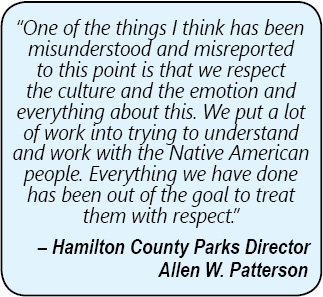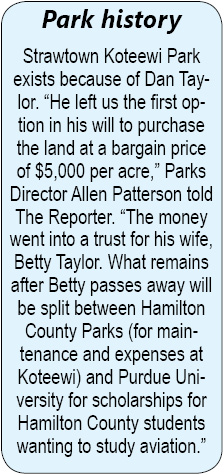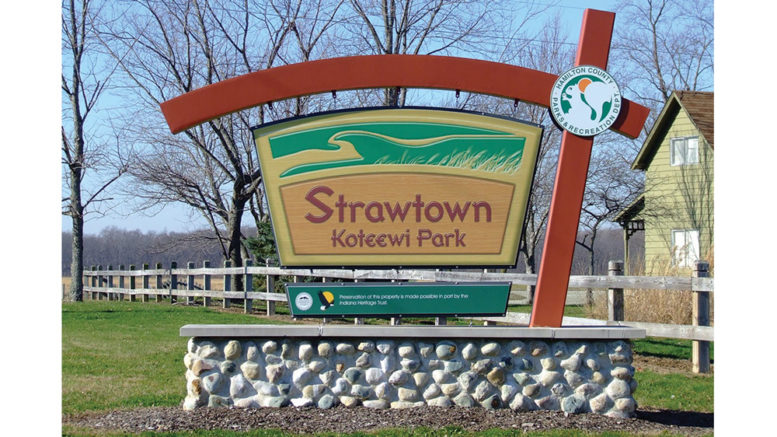Moving forward
Strawtown Koteewi Park has been the focus of media attention this year due to a controversary at the federal level about how Hamilton County Parks and Recreation Department (HCPR) handled Native American artifacts discovered during archeological digs on park grounds. A recent decision to reduce the monetary penalty to $6,533 has again focused attention on Koteewi.
According to a statement from the Parks Department, “The penalty was based on the park department’s non-compliance with provisions of the Native American Grave Protection and Repatriation Act (NAGPRA). The provisions were in regard to tribal consultations and inventory reporting.”
Director Allen W. Patterson stated that he accepted the decision of the U.S. Department of the Interior, and added that the department has taken steps to ensure future compliance with the NAGRPA guidelines.
Those steps include both a new policy and a new staff position to ensure greater compliance moving forward.
HCPR has put in place a “Collections Management Policy,” which includes a procedure for what must be done when encountering human remains.
Additionally, they have created a full-time staff position dedicated to overseeing artifact collection related activities and responsible for overseeing, on the department’s behalf, any archaeological activity on park property. The person filling that position for HCPR is Christy Bracken.
Bracken holds a bachelor of science degree in anthropology with a minor in native studies and geology and a Master’s degree museum studies. She began working part-time for HCPR on Dec. 12, 2011, and was moved to full-time position on June 12, 2014.
In 2013 HCPR received a copy of a letter written by the Chief of the Miami Tribe of Oklahoma to the U.S. Department of the Interior, dated Sept. 10, 2013. The letter reads, in part, “HCPRD has achieved compliance with the Native American Grave Protection and Repatriation Act (NAGPRA) and to acknowledge and express its deep appreciation for the hard work and dedication of the HCPRD in its work with the Miami and other historic tribes of Indiana.”
The letter went on to state, “The HCPRD and the Tribe have engaged in an extensive, on-going collaborative effort to achieve NAGPRA compliance and to build a positive future-looking relationship over the past 12 months . . . The Miami Tribe of Oklahoma acknowledges and appreciates the hard work and dedication of the staff at the Hamilton County Parks and Recreation Department to fulfill its requirements under NAGPRA. Despite a spare budget and a volunteer board, HCPRD was focused and engaged in the compliance and consultation process.”
The Miami of Oklahoma have control and possession of the original 12,000 artifacts covered in the claims for which the HCPR has been fined. “We are still working on documentation on the second group of +/- 90,000,” Patterson said.
Looking back
Trying to understand how Strawtown Koteewi Park became the center of this kind of controversy involves a few key points: Park officials both respect and care about the preservation of history in Hamilton County; they believed they followed the laws relevant to their archeological activities; they worked closely with the Native American people they were told to work with; and a relatively recent change in federal law appears to have affected their efforts retroactively.
It is important to note that Hamilton County Parks and Recreation (HCPR) was working for years under the understanding that they were in fact doing everything they were supposed to. They had filed permits with the Indiana Department of Natural Resources, Division of Historic Preservation and Archaeology (IDNR). When their archeological activities did turn up artifacts and remains, they were told by IDNR to deal with the Miami Nation of Indiana, with whom HCPR and Director Allen W. Patterson developed a good working relationship.
 “We were first notified in 2012 of the claims,” Patterson said. “That’s when we started consulting with the Miami of Oklahoma. We’d been consulting with the Miami of Indiana prior to that, but they are not a federally recognized tribe, even though we had been told by the state that they are who we should talk to.”
“We were first notified in 2012 of the claims,” Patterson said. “That’s when we started consulting with the Miami of Oklahoma. We’d been consulting with the Miami of Indiana prior to that, but they are not a federally recognized tribe, even though we had been told by the state that they are who we should talk to.”
Brian Buchanan, chief of the Miami Nation of Indiana, was not available to for comment due to a heath issue. But when asked about his relationship with Buchanan, Patterson told The Reporter, “Brian is a great man. We’ve got a great relationship with Brian. In the early 2000s, after the archeological investigations began, anytime we had a question that’s who they [the state] guided us to.”
There were multiple settlements over thousands of years imprinted on top of each other at Koteewi Park. All were pre-contact Native American villages and sites. “We have no idea if they were Miami,” Patterson said. “The Miami tribe has aboriginal land claims to this area, but because of the timing of the digs and the investigation there is no way to tie them to any specific historical tribe. And that law changed in 2010 or 2011. That is when the federal government started recognizing aboriginal ties to land. That in itself was a change and a challenge in trying to adhere to the federal law.”
The Miami Nation of Indiana has recognition from the State of Indiana, but not from the federal government. On the other hand, the Miami Tribe of Oklahoma does have federal recognition. Thus, HCPR had to step back from their working relationship with the Miami of Indiana in order to build a new relationship with the Oklahoma branch in compliance with federal law.
Before that change in the law, there was no provision for cultural affiliation of artifacts from a pre-contact era. “It was during that whole time that if something were found in a dig or discovered then we contacted the Indiana Miami and they actually performed repatriation ceremonies on site for us on a number of occasions,” Patterson said. “We felt very strongly about our relationship with the Miami of Indiana and it was very difficult to have to back off on our communications with them.”
Patterson said part of what he thinks is important about the work at Strawtown Koteewi is being able to tell the citizens of Hamilton County and our visitors about the history of Hamilton County at the property. “Any partners we have in that process that can help us tell that story—and as we can help benefit their cultures in any way and help them answer questions—that’s what we are here for,” Patterson said. “That’s why we are working with the universities and the tribe to gather this information. It would be a much different process and would be looked at much differently if we were just trying to clear land to develop a park.”
Koteewi has been given an archeology award by the State of Indiana recognizing their investment and efforts in forwarding archeology and history in the state. Patterson has been asked to speak at historic conferences.
“The Indiana Miami have partnered with us in programming for many years out there on site,” Patterson said. “In Indiana Archeology Month we have for many years been the number one most visited site. That’s not just because people wanted to come out there, it is because we have been promoting and actively presenting programs about archeology and about the history of that area. The tribes are a huge part of that. We have always welcomed that. That is part of what we thoroughly enjoyed in working with the Indiana Miami.”
 Patterson said he wanted to clarify what he describes as a point of misrepresentation by the media.
Patterson said he wanted to clarify what he describes as a point of misrepresentation by the media.
“One of the things I think has been misunderstood and misreported to this point: we respect the culture and the emotion and everything about this,” Patterson told The Reporter. “We put a lot of work into trying to understand and work with the Native American people. Everything we have done has been out of the goal to treat them with respect.”
Patterson told The Reporter he sees Strawtown Koteewi as existing in partnership not only with Hamilton County but also with the aboriginal people who were there before, in as much as they are able to build and maintain those relationships.
Regarding HCPR’s relationship with the Miami of Oklahoma, Patterson has a hopeful but guarded view of the future.
“The handful of consultations we had had on this larger number of artifacts have been challenging because the cultural difference plays a big part in things,” Patterson said. “We are looking at the law, saying, ‘we are following the law.’ I think that has strained relations a bit. We look forward to the point when we get through all of this and move on. Our contact is their tribal historic preservation officer, but unfortunately, as this thing has played out most of the conversations and discussions have happened between attorneys.”
Given the path they took to get here, as well as the vision Patterson describes for Strawtown Koteewi Park, history is alive and well in Hamilton County. The story of this controversy will even become a part of that.


A few thoughts in order of their mention in this ‘article’. I would encourage HCPR to be transparent with all stakeholders and taxpayers — post the Collections Management Policy online, in addition to the Memorandum of Understanding created with the Miami Tribe of Oklahoma.
I want to make a clarification concerning the staff person they have detailed in the article. The violations took place at specific times of the year during summer field schools and the yearly Archaeology Month excavations in September. During many of the September excavations, the staff person was actually on the IPFW staff of the archaeologist in question. And, the staff person started working for part-time for HCPR in June, 2006, not 2011 as stated in this article. Both these facts are significant to the mitigation claims of HCPR.
The 2013 letter from the Miami Tribe of Oklahoma cited in this article was written at a time when the tribe didn’t know that relevant inventory information was missing. It took several years more to resolve these issues, and others. This opinion is…. dated.
This article makes a number unsubstantiated, subjective assumptions in order to create a narrative sympathetic to HCPR. While readers should be skeptical of these, the fact that the state of Indiana encouraged HCPR to talk to the wrong entity is highly significant and a point that desperately needs to be addressed by both professionals and journalists. It isn’t the only element that created the situation, but it is key to much that unfolded at Strawtown.
In regard to the assertion that the law changed late in the game- readers should be aware that most of the NAGPRA violations concern failure to notify pertinent federally-recognized tribal entities. ‘Failure to consult’ only officially came into play in the years of 2010 and 2011. I would add that professional ‘best practice’ around the country has involved tribal consultation, literally, for decades.
It is true HCPR was recognized with an archaeology award by DHPA in the midst of all this work. The point taken from this fact should not be to say what a great job everyone was doing, but why DHPA was handing out awards while National Register sites were being impacted, annually, with their blessing, putting both the sites’ historic integrity and their protected status, at risk? Where was the oversight?
HCPR administration’s feelings about consulting with the Miami Tribe of Oklahoma are irrelevant. They are the only entity that can be consulted according to a decision by NAGPRA that has yet to be fully appealed. Other federally recognized tribal entities should also have the legal standing to consult at Strawtown.
I would encourage readers to refer to the original article in the IndyStar (Nov. 2016, “Eternal Unrest”) for more specific details.
I would encourage journalists to investigate other facets of the situation at Strawtown by interviewing a range of people directly involved with the relevant institutions including but not limited to HCPR, IPFW, NAGPRA, Indiana Dept. of Historic Preservation and Archaeology, and National Park Service.
Transparency has always been the issue. After a park visit in 2009, I met with Al Patterson, Ms. Brocken and staff members to discuss the reburial of a burial urn that took place illegally at the park. No mention of human remains being encountered or recovered from park sites even though numerous remains and associated funerary objects were sitting on the shelves of the Taylor Center at that time. Only in 2011 did we learn of human remains being found at the park by the lead archaeologist and then he lied about how many were found and needed to be reburied. Then we learned that archaeologists from Ball State informed the park of its NAGPRA responsibiilties as early as 2004. Was this intentional disregard for federal laws? You be the judge.
Seems shady to me. I think it shows how little we respect Native Americans. I think the prudent thing to do would be to give that ground to the Miami tribe. The park should also be respectful and stay away from that land. I wouldn’t want my ancestors land treated that way without out consent and damn sure wouldn’t want to have them be neighbors with the people that did it to them.
HCPR submitted false and inaccurate information for publication in the federal register stating the human remains and associated objects were only recovered during 3 years excavations at the park when, in fact, they were found and recovered during all 11 years of digging at park. This may not be criminal but it surely dishonest and very unethical.